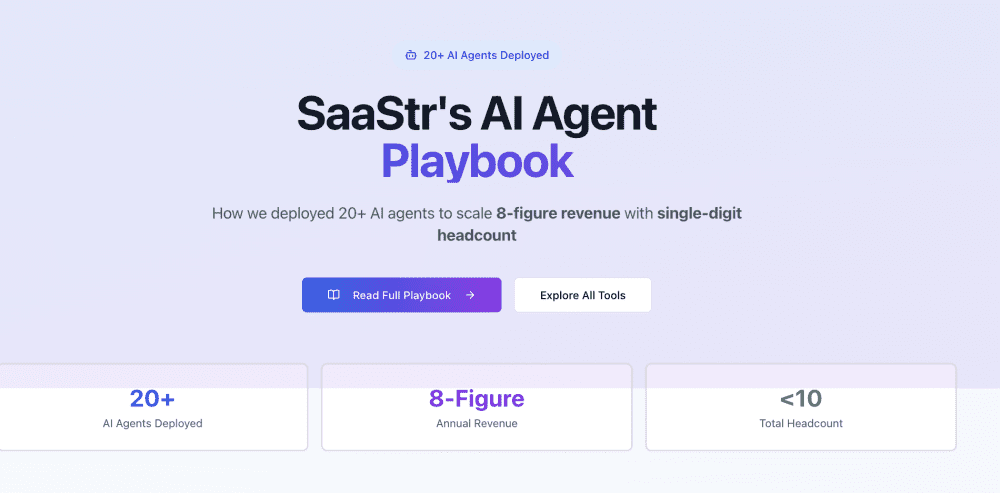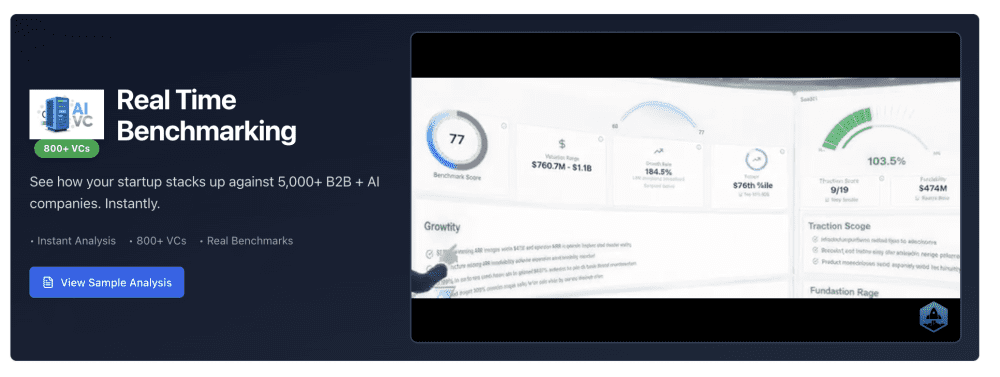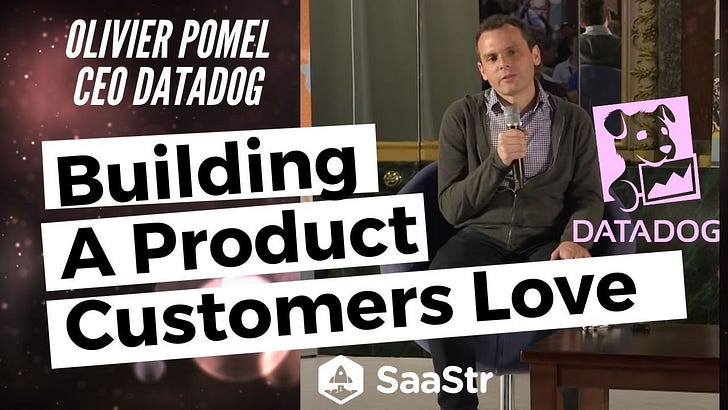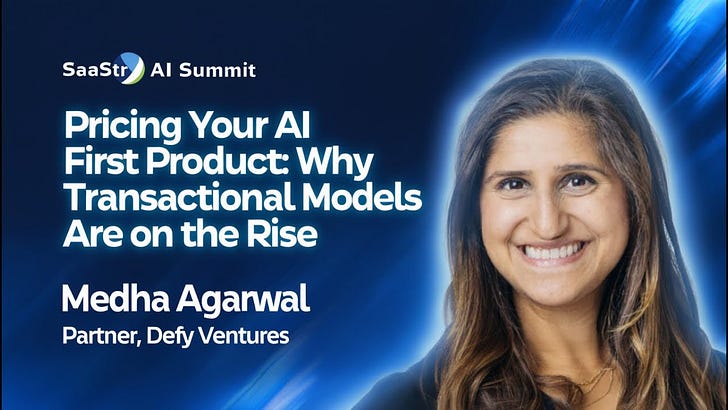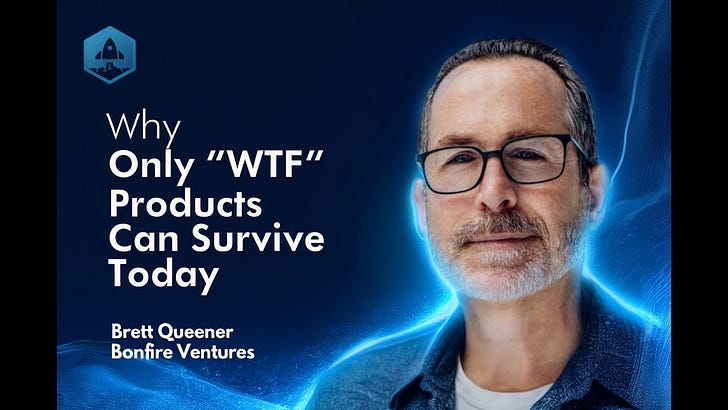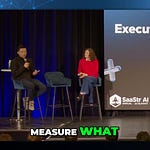The State of AI + Software: Where It’s Going - Fast
This deep dive is from Jason Lemkin at the LIVE AI Workshop Wednesday. Sign up here for the next one.
I was talking to a founder recently who’s running at $50 million ARR. Classic SaaS guy turned AI guy. And he’s going to scale from $50M to $100M with just five sales reps and a team of AI agents.
In the old days, at $50 million, you’d probably have at least 100 sales reps. Why? Because to get from $50M to $100M, you need $50M in net new bookings. At $500K net per rep (which is pretty good when you factor in scaling, turnover, and ramp time), you’d need 100 bodies. Minimum.
This founder? Five human reps. Plus AI.
It’s not that he doesn’t need sales reps. It’s not even that he’s not selling. He’s actually doing classic B2B SaaS sales. He’s just doing it with dramatically fewer humans, and for the purposes of this discussion, he’s doing it so much more efficiently. And he has 10,000+ inbound leads a month flowing through this system.
This is where we are right now. And if you’re not paying attention, you’re already behind.
Everything Changed For SaaStr Itself in the Last 180 Days
At the end of Q1 this year, we had zero AI agents in production at SaaStr. Nothing. Nada. We were thinking about it, but we hadn’t deployed anything.
Fast forward to today, and we’ve got:
Almost 20 AI agents running in production
Four different AI SDRs deployed and actively working leads
Salesforce Agent Force rolled out (just started yesterday, so we need a bit more time before sharing all the data)
An AI BDR from Qualified handling inbound qualification
A slew of specialized agents for support, research, and operations
It is so much different even on our little team than it was even 100 days ago. And it’s going to keep changing at this pace.
I’ll be honest: we were probably a little behind the curve at the start of the year. Now, we’re kind of at the bleeding edge. And we want to drag everybody along with us because everything’s changing.
The models are changing. The tools are changing. Things that didn’t work last year can work really well now.
Everyone complained about how crummy AI SDRs were last year—and there still are a lot of issues—but now we know how to train them. Now we know how to iterate with them. Now we know how to make them work.
There’s so much more coming, and marketing in some ways is even further behind sales. But it won’t be for long. This whole space is going to radically change in the next 12 months.
More on our AI Agents here.
The Single Most Important Thing You Need to Do to Stay Relevant
Here’s my advice, and I mean this with every fiber of my being:
If you feel behind in AI and go-to-market, the answer is simple: be part of a deployment.
Not just “buy a tool and forget about it.” That teaches you absolutely nothing.
Go buy any tool. Go buy any tool that comes and talks at events. Go buy any leading tool in the space. At some level, it doesn’t even matter which one you start with.
But here’s the critical part: Don’t just buy it. Be part of the deployment.
Train it yourself
Be part of the onboarding
Be part of the errors and the issues
Be part of the daily iterations you have to do to get it working
Don’t just set and forget. You will learn nothing. You will learn absolutely nothing.
Be part of a deployment to see how it really works. Otherwise, you’ll never really learn.
You don’t have to become a vibe coder like I have. You don’t even need to play with the underlying tech. What you really need to do is get your hands dirty with actual implementation.
The Iconiq Growth Report: 10 Things That Show How Much the World Is Changing
Iconiq Growth—one of the top late-stage B2B growth funds forever, from the early days when they managed Mark Zuckerberg’s family money to being in so many leaders from Canva to Anthropic and beyond—just put out an incredible report.
https://www.saastr.com/iconiqs-state-of-software-in-2025-much-smaller-teams-55-of-gtm-is-now-in-post-sales-2025-is-crushing-2024-for-funding/
It’s almost 100 pages. There’s a lot of detail in there about public companies and nuances that a lot of you don’t really care about. But I picked out what I think are the 10 most relevant things to SaaS folks for B2B that show just how much the world is changing.
A lot of folks are behind here. A lot of folks. And it’s okay—it’s not necessarily fatal. We’re not all being killed by ChatGPT and Anthropic. But the world is changing. This data shows you just how it’s changing and how we all have to adapt.
1. AI Native Companies Are Burning Less (Way Less)
This first data point explains a lot of things that are really confusing on social media. People say, “Oh, these AI native companies, they’re burning all this cash to acquire customers with free tiers and consumption models.”
Actually? Not true.
AI native companies burn substantially less than classic SaaS companies did at the same stage. Why? Because they don’t need to hire armies of people to scale. The unit economics work differently when AI is doing a significant portion of the work.
2. The Sales Team Size Cliff
We’re seeing companies hit $10M, $25M, even $50M ARR with radically smaller sales teams than the old playbook required.
The old rule of thumb: you needed roughly one sales rep per $500K-$1M in ARR, depending on your ACV and sales cycle.
The new reality: AI-native companies are operating with 20-30% of the headcount at equivalent revenue levels.
That $50M company I mentioned at the beginning? That’s not an outlier. That’s the new normal for AI-native companies.
3. CAC Payback Periods Are Compressing
Customer Acquisition Cost (CAC) payback periods are getting shorter in AI-native companies. Not because they’re spending less on acquisition (though some are), but because they’re able to onboard, activate, and expand customers faster with AI-powered customer success and product experiences.
We’re seeing companies hit CAC payback in 6-8 months that would have taken 12-18 months in the classic SaaS playbook.
4. Net Revenue Retention Is Under Pressure Everywhere
Here’s the uncomfortable truth: Net Revenue Retention (NRR) is declining across the board.
Even the best SaaS companies are seeing NRR pressure. Why?
Competition is fiercer than ever
Customers are more price-sensitive post-2021
AI is enabling customers to do more with less, reducing expansion
New AI-native alternatives are constantly emerging
The days of 130%+ NRR being table stakes? Those are largely over. Now, 120% is excellent. 115% is solid. And anything above 110% in the current environment is worth celebrating.
5. The Growth Multiple Advantage of AI Companies
Here’s where it gets really interesting: AI companies are trading at higher multiples than pure SaaS companies at equivalent growth rates.
Why? Because investors believe:
The TAM is larger (AI can address bigger markets)
The margin structure is better long-term
The defensibility is stronger (data moats, model improvements)
The growth trajectory is more durable
A SaaS company growing 100% YoY might trade at 10-15x ARR. An AI company growing 100% YoY? We’re seeing 20-30x+ ARR in some cases.
6. Time to $10M ARR Is Accelerating
AI-native companies are hitting $10M ARR significantly faster than classic SaaS companies did.
Classic SaaS: 3-5 years from founding to $10M ARR was typical for fast-growing companies.
AI-native: We’re seeing companies hit $10M ARR in 18-24 months.
Why? Product-led growth combined with AI efficiency. Lower go-to-market costs. Faster time to value. Viral distribution.
7. The Disappearance of the Middle-Market Private Equity Exit
This one is painful but important: The private equity exit path for $20M-$50M ARR SaaS companies has essentially disappeared.
In the 2010s and early 2020s, if you had a solid SaaS company growing 30-50%, your burn rate was low, and your NRR was high, maybe VCs wouldn’t touch you, but a private equity firm would come in and buy you for 6x to sometimes 10x revenue.
You’d get to $20M revenue growing 50-60% and cash flow neutral. No VC was going to fund you there, but a PE firm might buy you for $150M or even $200M.
I don’t see any of those deals anymore. They’ve disappeared.
Why? Because private equity isn’t immune to the fact that:
Public SaaS companies have seen growth decay
NRR isn’t as sticky as it used to be
New AI vendors are putting the old guys at risk
So PE has disappeared from this segment, and VCs have flocked to hyper-growth AI companies.
This may or may not change, but at least don’t live in a dream world where you think the next round is going to come because growth is “pretty good.” It won’t.
8. If You Have Any Doubt About Fundability, Check the Data
We literally added a new benchmarking tool at SaaStr.ai. It’s our third tool there. Go to saastr.ai, click “AI VC” at the top.
Upload your latest investor update or board deck or VC pitch. We will tell you the exact odds you get funded. The exact odds.
And if you don’t like it, don’t shoot the messenger. It’s based on all the recent data from 5,000+ rounds.
I talk to way too many founders who think they’re going to get funded in B2B, and they’re not. So just at least find out. We built the tool. It’s benchmarking. It’s cool.
9. AI Is Creating a New Category of “Efficiency Giants”
We’re seeing the emergence of what I call “efficiency giants”: companies that can reach $100M+ ARR with teams that would have been laughably small in the SaaS 1.0 era.
These companies have:
Sub-50 person teams at $50M+ ARR
Gross margins in the 85-90% range
CAC payback under 6 months
Growth rates still above 100% YoY
These aren’t just outliers. This is becoming a category.
10. The AI-Native Stack Is Real and Growing
Companies are increasingly building on what I call the “AI-native stack”: infrastructure, tooling, and platforms designed specifically for AI workloads and AI-powered applications.
This includes:
Vector databases (Pinecone, Weaviate)
LLM orchestration layers (LangChain, LlamaIndex)
AI observability and monitoring tools
Model fine-tuning and deployment platforms
The total spend on AI-native infrastructure is growing 300%+ YoY, creating a massive new category of B2B software.
The Hard Truth About Introducing AI SDRs to Your Team
Someone asked me a great question in the live AMA: “How do you start to thoughtfully introduce AI SDRs to the sales team without scaring off the existing SDRs?”
I was literally dealing with this yesterday. I was at the company all-hands for a company I invested in called MangoMint (SaaS + AI Agents for salons, spas, and doctor’s offices). Great company, great CEO, great culture. People were just so excited at their all-hands.
The CEO asked just one favor of me, “Just do me one favor: don’t scare the SDRs.” He said, “Don’t scare them with all this stuff.”
I said, “Okay, I won’t.”
But actually, I’d already had lunch before the presentation. I sat down at tables with all the SDRs. I’d already had the conversation with them.
They understood that the best have as important a role as ever, and the others don’t.
The VP of sales sat down with me afterward and gave the same message. She said, “We’re aggressively all-in on these tools, and we’re growing. We’re growing triple digits at 8 figures in revenue. This is the future. We have to embrace it.”
So look, here’s the hard truth: If your SDRs are going to quit because of AI, they’re going to quit anyway.
And the tenure of an SDR is very short to begin with. Just be clear: we need everybody who can perform.
It was funny. We were sitting there at lunch with the SDRs, and one of them was one of the best ones on Marshall’s team. I’m sitting next to her, and she’s already got her laptop up. She’s scanning a salon that she’s doing outbound to during lunch. She’s literally doing true outbound research during lunch.
She’s got a job forever.
The SDRs that just want to run random emails and never learn the product? They don’t.
I think we’re past the point where you have to worry about scaring the team. Be kind. Make sure everyone who crushes it knows that everyone who is A-tier on your team has a role. That hasn’t changed.
It’s even harder to find A-tier folks now. But if folks don’t want to adapt, they won’t have a future. And I think you’re better off being straightforward with them.
Just do it.
Here’s the other thing: As soon as you actually roll out the tool, someone’s going to quit anyway.
This is the story with every company I’ve invested in. Even at SaaStr, on our little team, we rolled out a tool called Momentum (or it might have been from Attention—they’re great too).
Even on our little team, the day we rolled it out, someone on our sales team quit. The day we rolled it out.
Why? Because now all his actions, all his data were going to show up in real-time in a report and in Salesforce. You couldn’t hide. You couldn’t pretend you did five calls this day when you didn’t. You couldn’t pretend you did the work when you were out at this tool.
Somebody quits. And honestly? It’s all for the best. The truth is, it’s all for the best.
We’ve got to get out of kumbaya land because this is a new high-growth world. You’ve got to be a part of it.
The Real Cost of Implementing AI: What You Actually Need to Budget
Another great question: “How much should we be estimating for cost to invest per year in AI to get started?”
This is better than it sounds, and the answer is going to surprise you.
Let me give you the SaaStr example. We’re tiny. We spend maybe $10,000 a year on Salesforce. Maybe a little more. And the same or a bit more on Marketo, which we essentially use as a CRM for our community (Salesforce is our CRM for sponsors and ‘sales’).
I’ve been a Salesforce customer for 20 years. First piece of SaaS I ever purchased for real. I never paid for anything before Salesforce.
But here’s the thing: we spent maybe $10K on Salesforce notionally.
We spent $500,000 on our AI agents across these 21 agents. $500,000.
Think about that ratio for a minute. There are so many learnings in that ratio.
It’s why Salesforce has to own Agent Force. They have to win. It’s why HubSpot has to win here.
But we are spending far more on agents than we are on CRM. That’s a meta thing to think about.
The Real Cost Structure of AI Tools
The second thing to think about: these apps that need to be trained with forward-deployed engineers and hands-on work? I don’t think very many of them are less than $30,000 or $50,000 a year.
A lot of them actually try to have a price point that’s approaching $100K—like $60K a year base, and then $20K or $30K for the forward-deployed engineer and training.
Sometimes they include it, sometimes they charge for it. Whether they do or don’t, it ain’t free to do it right.
For me, I would certainly subsidize it if I were a vendor, but it costs that amount. Having a really great technical resource help you train your AI for a couple of weeks? That’s not free. It’s pretty damn expensive.
And this relates to the meta issue: You’ve got to invest the time.
There’s a reason these apps cost $50K to $100K. They are a lot of money. Be wary of super cheap apps. Be wary.
It’s not that we’re not getting there. It’s not that everything isn’t going to get better. But you can’t cut corners on training.
If instead of $50K a year, you’re buying a solution that’s $500 a month or $50 a month, I’m not saying it’s not going to work, but you’re going to have to do even more training. You better take on a massive amount of burden to train this app because you’re not getting the benefit of the forward-deployed engineers and all the training, tuning, warming, and everything the vendor does.
There’s no shortcut here. There is no shortcut.
It is an existential issue. This will change over time, but right now, the agents can’t train the agents themselves the way the best humans can.
It’s tough to get away with less than $30K-$50K for any of these tools when a month of training is required—or at least several weeks.
What This All Means for You
Look, I get it. This is overwhelming. The pace of change is brutal. Every time you think you’ve figured something out, the models get better, the tools evolve, and the playbook shifts.
But here’s what you need to take away from all of this:
1. The efficiency advantage is real. AI-native companies are operating with dramatically lower costs and higher margins than classic SaaS ever could. If you’re not thinking about how to capture this advantage, you’re leaving money—and competitive positioning—on the table.
2. You can’t learn by observing. You have to deploy. You have to train. You have to iterate. Reading blog posts and attending webinars isn’t going to cut it. Get in the arena.
3. The funding environment has bifurcated. Hyper-growth AI companies are getting funded at eye-watering valuations. Solid but unspectacular SaaS companies are getting passed over. Know which category you’re in and plan accordingly.
4. Your team structure needs to change. The old GTM playbooks are dying. You don’t need 100 SDRs to scale to $100M anymore. But you do need the right people who can work alongside AI, train it, and amplify their effectiveness with it.
5. Budget for this properly. You’re going to spend more on AI agents than you think. And that’s okay—the ROI is there. But don’t go into this thinking you’re going to deploy enterprise-grade AI solutions for $500/month. You’re not.
6. Speed matters more than ever. The companies that figure this out in the next 12 months are going to have a massive, compounding advantage. The companies that wait are going to find themselves 18-24 months behind, and in this market, that might be fatal.
The Bottom Line
We’re in the early innings of the biggest shift in B2B software since the move from on-premise to cloud. Maybe bigger.
The companies that win are going to be the ones that:
Deploy aggressively
Learn constantly
Adapt their teams and processes
Invest in the right tools and training
Move fast without breaking (too many) things
The companies that lose are going to be the ones that watch from the sidelines, wait for “best practices” to emerge, and try to protect the status quo.
Don’t be the second group.
Get in. Deploy something. Train it. Break it. Fix it. Learn from it.
That’s the only way forward.
And if you want to learn more about how we’re doing all of this in practice, come to SaaStr AI in London on December 1-2. We’ll have speakers from OpenAI, Whiz, Clay, Intercom, Fin, and all your favorite B2B + AI companies.
We’ll do live sessions. We’ll share real data. We’ll show you what’s working and what’s not.
Because this is changing every quarter, and we’re all learning together.
Let’s go.
Want to see if your company is fundable in today’s market? Check out our AI VC benchmarking tool at saastr.ai. Upload your deck and get your exact odds. It’s free. It’s data-driven. And it might save you months of wasted pitching.

